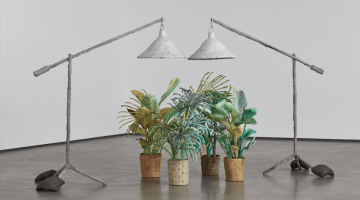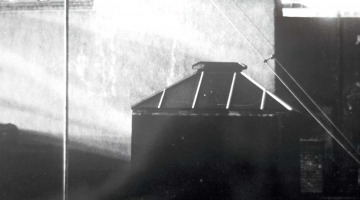Forrest Bess died as he lived, in virtual solitude with his artistic struggle as his companion. For the first time in over twenty years (and showing into the New Year), Hammer Museum has mounted a retrospective of the little known, soul wrenchingly poignant Bess. Curated by Clare Elliot, Associate Curator at the Menil Collection in Houston, “Forrest Bess: Seeing Things Invisible,” amasses a retrospective that tells one human’s emotional struggle through paintings and the “thesis,” that plagued him. Each work does not simply shine with contented air of stereotypical symbolism aligned with emotional duress (some variation of a blue period or, a primordial scream). It is an intangible buzz that the gallery emits. This is all done through canvas after canvas of (mostly) abstractions scrawled on modest sized surfaces with crude framing. Rothko be damned, Hands down, “Forrest Bess: Seeing Things Invisible,” could easily be considered the most transcendental, enlightening and heart breaking experience an institute of this magnitude has had the gall to show in 2013.
The first child of Butch and Minta Bess, Forrest Bess was born in 1911, outside of the coastal Texas town of Bay City. By trade his father was a Bait Fishermen- a tradition Bess would later take up. Despite artistic leanings, Bess was expected to go to West Point Academy, which he did, only later to flunk out. Around 1941 as the United States entered WWII, Forrest decided to join the fight, enlisting and quickly scaling the ranks. It was in his service, that Bess’s life would take a permanent detour. On a late evening having consumed too much alcohol and experiencing in Bess’s words, “too much excitement,” he came out to a fellow soldier. Bess was beaten severely. As he convalesced in a Military Hospital, a psychiatrist (whose name Bess had since forgotten) observed his interest in painting and recommended he take it up as a therapeutic means. Beginning at first with landscapes and still life’s, Bess soon began to paint the imagery that plagued him exponentially, since he was assaulted. As Bess lay in bed at night, his mind slipping into unconsciousness, primitive shapes, vibrant colors and tessellating patterns would dance in his mind. Bess diligently kept a notebook by his bed (unfortunately, all have since been lost). Ripping himself from near slumber, he would painstakingly jot each shape down. Later, following his day’s work as a bait fisherman, Bess would return to his ramshackle home built by his own two hands, to paint what he referred to as his “visions.” It was a solitary existence, yet a chosen one.
Concurrently, Bess maintained a correspondence with Betty Parson’s, an early admirer and collector of his work. Parson’s recognized the emotive energy in his pieces exhibiting them in her celebrated New York City gallery next to Abstract Expressionist superstars as Jackson Pollack, Barnett Newman and Mark Rothko. Still, nearly sixty years since their creation, Bess’s paintings maintain a frenetic energy, each shape, curvature of a line or thickly wielded, textured oil paint application is seemingly more an encapsulated extension of Bess than a creation by. Peering onto any of these works, feels like looking into Lenin’s Mausoleum.
Bess felt within each vision, and respective creation, there laid answers: to his sexuality and more importantly, his existence. In an interview, Robert Gober noted it was at this point which Bess “cast a wide net,” looking to cave drawings, color as symbolism, Freud and the newly formulated field, “sex therapy,” to ascertain any significance or similarities with his work and fields of studies that had come before. At one point Bess discovered Hermaphroditism. And thus, his “Thesis” was created. Colors, symbols, as he understood reflected the necessity to possess both sexes- the male and female. This culminated in a self-administered surgery. In a particularly vivid letter, Bess recanted this experience to Parson’s, the tone- euphoric relief. Now, the visions that plagued him, the urgency within him to know more, had come to a conclusive path. Painstakingly, Bess created an anthology of his studies, including graphic images of his incision, with the intention to show alongside his paintings. Bess wrote to Parsons requesting she do just that. Parsons politely declined. Bess’s “Thesis,” in its entirety has since been lost, but Gober through research found what is believed to be a remaining portion of it. For the first time, Bess’s woks are exhibited side-by-side with the remaining portion of his “Thesis.”
Jackson Pollack famously stated, “I am nature.” When compared to Bess you cannot help but consider this to be even more bombastic than before. Bess’s monk-like existence subsisted on his creations: each abstraction consumed his mind and permanently altered his flesh. The works alone are powerful compositions of color and restraint. Yet, it is Forrest Bess’s existence that contributes to its power. Nothing conceptually gimmicky or presumptuous, “Forrest Bess: Seeing Things Invisible,” is about an artist struggling to maintain semblance in an era that demanded normalcy. The world certainly needs more celebrations of exceedingly talented, humble, humanistic spirits like Bess.
“Forrest Bess: Seeing Things Invisible” is on view through January 5th, 2014.
For more information visit the Hammer, Los Angeles.
-Contributed by Bianca Guillen
Previous reviews by Bianca Guillen:
–Review: Eric Yahnker’s solo exhibition “Ebony & Benghazi” at Ambach and Rice, Los Angeles.







